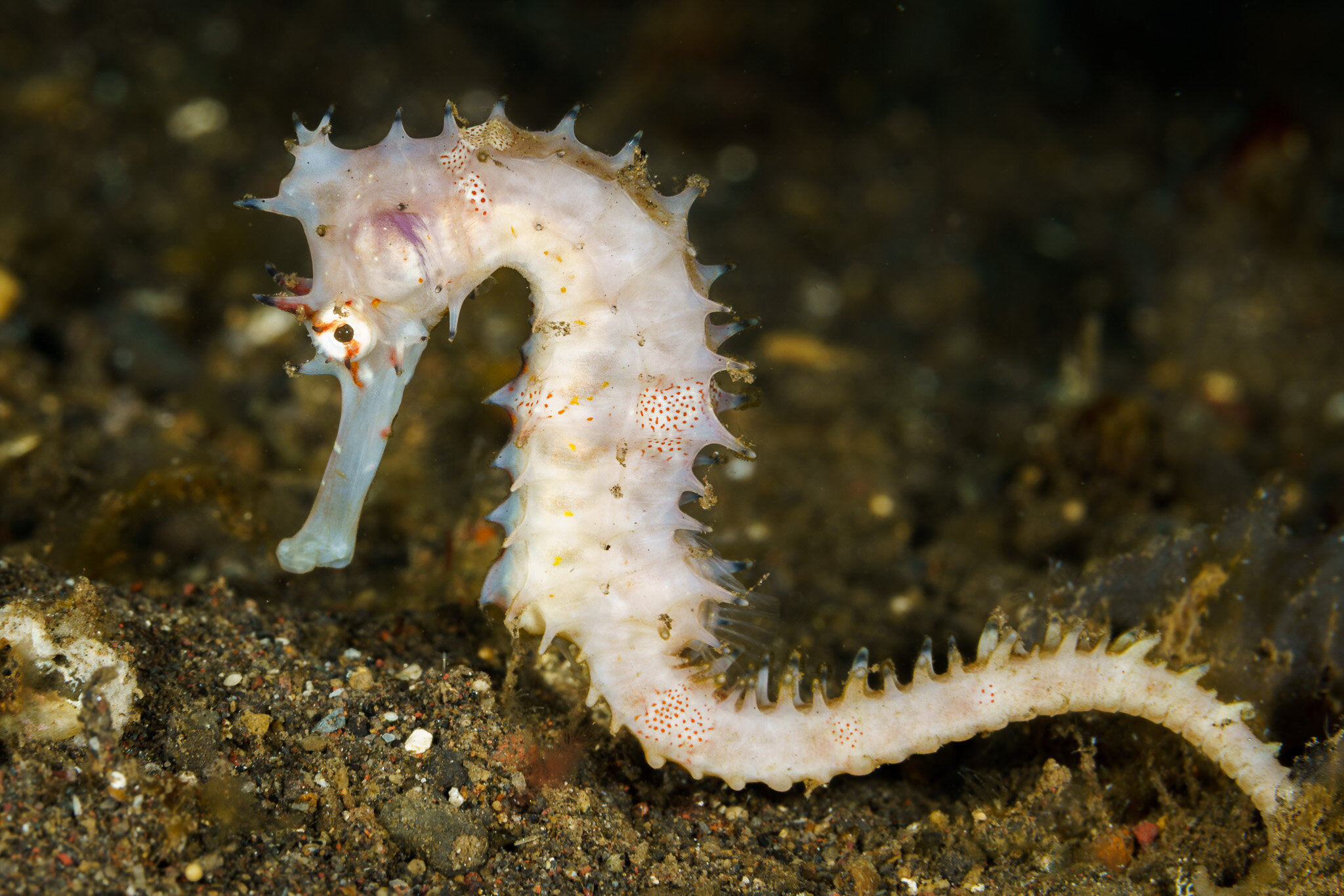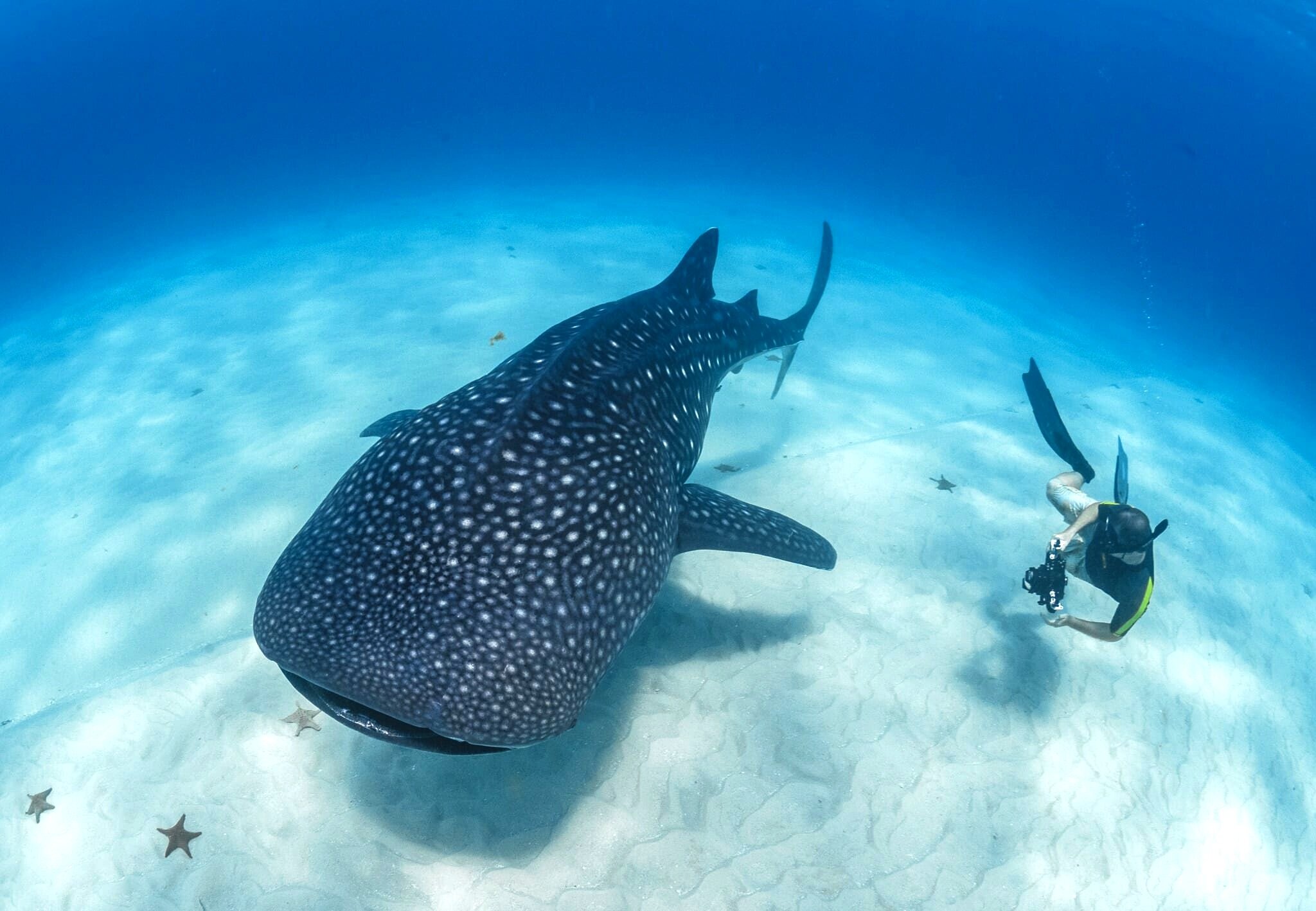Tulamben Diving: Exploring the Mucky Wonderland of Bali
Dr. Simon J Pierce is a co-founder of the Marine Megafauna Foundation, where he leads the global whale shark research program, and an award-winning marine wildlife photographer. About Simon.
A white morph of the ornate ghost pipefish seen while diving at Tulamben, Bali, Indonesia
While staying on Nusa Lembongan I asked Indo expert Brooke Lorianne what her favorite underwater macro location was on Bali. Tulamben? Sold!
Then I just had to find out where Tulamben was…
Don Silcock’s fantastic resource website for divers, Indopacificimages, is always worth a read. His Bali guide added Don’s own firm recommendation for the area, and put forward Scuba Seraya Resort as an excellent base for “muck diving”.
Wait, muck diving? That sounds… different?
Yeah, I hear ya. If you’re into blue water and gorgeous coral, this ain’t the place for you. There’s one “classic” (and extremely popular) dive in the area, the Liberty Wreck. Aside from that, you’re mostly diving on what divers call muck. I’d call it sand, because marketing. Regardless, it isn’t particularly inspiring to look at.
The animals that live here, though, are fantastically, mind-blowingly diverse. After three solid days of diving, I’m completely hooked. Tulamben, close to the spectacular Mt Agung, is stunning, Scuba Seraya is one of the nicest little dive resorts I’ve stayed at, and the diving… well. Let’s talk about the diving!
A hairy squat lobster on a barrel sponge
What’s the diving like in Tulamben?
The shore dive immediately in front of Scuba Seraya used to be called “Seraya Secrets”. Our guide explained that they’re just calling it the house reef now, as “the secret is out”. He’s not wrong. It was quite busy out there at times, although staying at the resort made it simple to plan dives during quieter times of the day (meal times!)
It’s worth it. Wander a few meters into the sea and, after a short swim, you’ll be appreciating harlequin shrimp, ornate ghost pipefish (both black and white variations), hairy squat lobsters, and a huge number of other fancy critters.
A harlequin shrimp eating a starfish arm at Tulamben, Bali, Indonesia
Further afield (but within 10 mins boat ride), we had seahorses, wonderpus octopus, Shaun the Sheep nudibranchs, and frogfish. All that, underneath an awe-inspiring volcano. Take me back. Immediately.
A tiny “Shawn the Sheep” nudibranch, named after the character in Wallace and Grommet, spotted while diving at Tulamben in Bali, Indonesia
This is a natural habitat for underwater photographers and marine critter aficionados, so most of the divers you’ll see (away from the Liberty) are very competent. You’re even welcome to do the shore dive at Seraya in your buddy group any time you like, unguided, though I’d definitely recommend having a guide to show you around – they’re fantastic at finding things!
Wonderpus octopus (Wonderpus photogenicus) seen while diving at Tulamben, Bali, Indonesia
The dives are deeper than I would have expected, down to around 27 m. We paid the (small) surcharge for nitrox fills, which were well worth it. I also rented a 15l tank, allowing us to stay down for about 60-70 minutes each dive, working our way up into the shallows for our 5 m safety stop before walking up to the dive center.
Planning a trip? Don’t forget to purchase travel insurance!
We use World Nomads to insure us while we’re scuba diving, snorkeling, hiking, on safari, in the Arctic… whenever we’re out and about while overseas. We’ve written up a full article on why we like World Nomads here on the site.
The water is lovely and warm – about 30ºC in April when we were there – so I was toasty in boardshorts and my warm rash shirt and Sharkskin hooded vest. Full rental gear is available on-site too.
A nudibranch at Tulamben, Bali, Indonesia
The four of us (Mads & I, plus our friends Dr Clare Prebble and Dave Levack) dove at a relaxed pace: 2-3 dives per day, mostly shore dives. We set our own schedule and had the same really nice guide the whole time (Komang Sukadana). He was an amazing critter-finder. All the staff were super helpful – they set up and de-kit your gear, help you in and out of the water, and are always around if you need them.
Diving the Liberty Wreck
Madeleine enjoying the Liberty Wreck off Tulamben, Bali, Indonesia
We did one early morning dive at the Liberty. It was fun, although there was plenty of company. The crowd was actually thinning out as we were leaving, and the light was getting far better, so I’d suggest having an early or late breakfast and starting your dive while the first groups are leaving.
A pufferfish at the Liberty Wreck at Tulamben in Bali, Indonesia
The wreck itself was interesting, and there was a hawksbill turtle and a few decent-sized fish around. There are probably some good photographic opportunities available inside the wreck (it’s very open), so stick your head in and take a look around.
Don Silcock has written up a great, detailed guide to the Liberty Wreck, so check his site out for more information.
When to go?
A white seahorse on sand at Tulamben, Bali, Indonesia
Komang told us he thinks the best time to dive is November. I’m keen to get back there later this year if I can swing it. April was still pretty goshdarn fun though!
Don, again, has useful information to add here:
The very best time for diving Tulamben Bay is October and November…
The period at the start of the southeast monsoon in May, June and through to about mid July also offer good conditions. But after that for about 2 to 2.5 months high winds create rough seas and poor conditions. Around the end of September the conditions start to improve again.
Generally from December through to early April, when the northwest monsoon is at its peak, there are strong winds and rough seas.
Where to stay?
Scuba Seraya! That was definitely a great option. It’s quiet, perfectly located, the rooms are comfortable – Clare and Dave stayed in one of the luxury villas the first night, and loved it – and the food in the restaurant was good and inexpensive. (Chicken satay for the win.) A great breakfast is included. I don’t like randoms touching me, but the other three were off getting massages every five minutes. It’s all pretty idyllic.
A yellow shrimp camouflaged on whip coral at Tulamben, Bali, Indonesia
The resort is well set up for photographers, with a camera room at the dive center, and there was great service all-round. We had a few issues with our transfer (the ferry went to an unexpected port) and the office staff and driver were both amazing.
A juvenile batfish mimicking a leaf underwater at Tulamben, Bali, Indonesia
Otherwise, next door there’s Villa Markisa, which I’m told is really nice, and Tulamben proper is close by. Brooke mentioned she usually stays in Amed, which is around 20 mins drive on a scooter. The diving is good over there too, apparently. A quick look on AirBnB uncovered some lovely villas for rental, which we’ll certainly consider if we do a longer-term stay.
Photographic considerations
I updated my post on underwater macro photography with the Sony A7rIII following this trip. There are lots of specific details there on settings and equipment etc.
A small fish protecting its eggs spotted while diving at Tulamben, Bali, Indonesia
One significant downer for me is that the guides in the area seem very “pokey”. I guess a lot of photographers want their guide to maneuver a subject to a “better” location, but I just want to see the animal in its natural habitat. See a good article here for some comments on ethics in underwater macro. Here, guides had clearly been hacking off starfish arms to deliver to the harlequin shrimps to keep them in an area where they could be easily found.
I’d suggest that, in muck diving and macro photography sites in general, it’s extremely important to talk to your guide about your expectations, and what you consider to be appropriate behavior.
If you want to learn or improve your underwater photography, I highly recommend Alex Mustard’s book: Underwater Photography Masterclass. It’s a fantastic guide to a rather technical subject!
Anyway, aside from that, everything was fantastic. We typically did two shore dives in front of the resort each day, and one boat dive to check out a few other sites within a short ride from Scuba Seraya… and to enjoy the view of nearby Mt Agung, which looms over the landscape in truly impressive fashion. You can set your own schedule, and dive in your own group, which we thoroughly enjoyed.
A nudibranch spotted while diving at Tulamben in Bali, Indonesia
You can do the shore dives unguided, but I’d definitely recommend having a guide – they’re fantastic at finding things! Mads is a great spotter, but I’m useless. Having a guide makes these dives extremely productive for macro photography.
Getting to Tulamben
Tulamben village is in northeast Bali, only two-hours drive north from Kusamba, which itself is just a short ferry across from our base on Nusa Lembongan. I love Bali logistics – everything feels so easy over there. We organized a bus transfer for the four of us from Kusamba with Scuba Seraya, and we were diving in Tulamben that same afternoon. Simples. Scuba Seraya can also arrange transfers to or from the international airport at Denpasar in Bali.
Other things to do
The area is beautiful – I thoroughly recommend renting a scooter (moped) for some exploration. Komang, our guide set that up for us. There are some nice restaurants (warungs) in both Tulamben, which is just down the road, and Amed which is about a 20 min drive.
From Tulamben, it’s easy to head to other diving destinations, such as Nusa Lembongan to the south, or the other muck diving sites along the north coast.
Hope that helps you plan your trip! We can’t wait to get back there.
Simon.

















